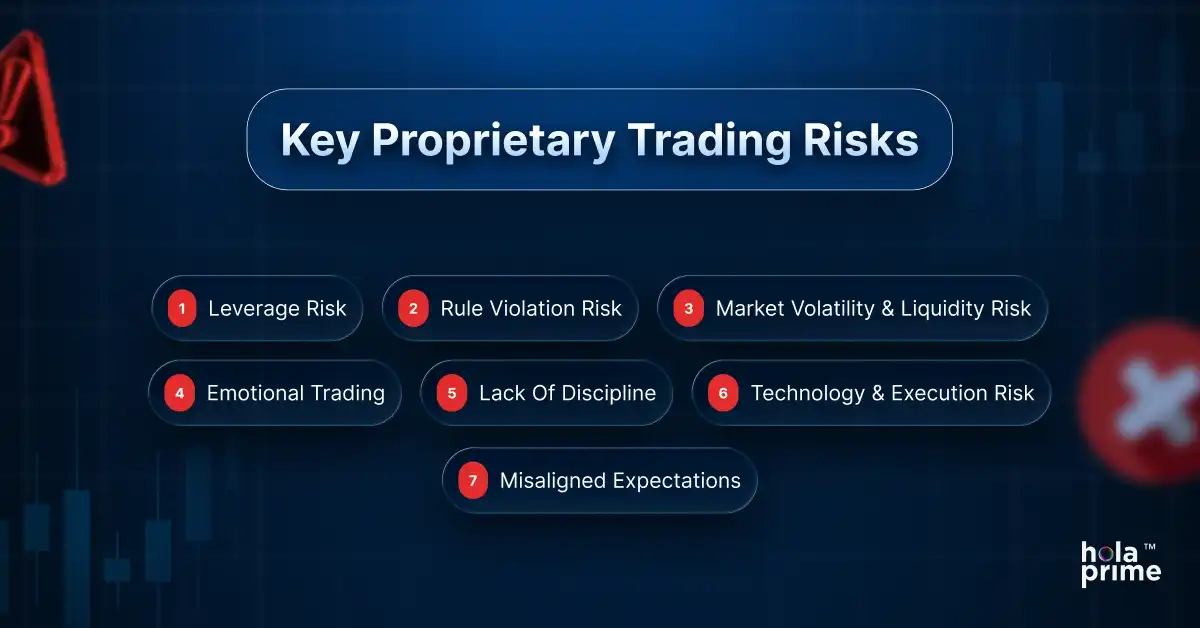Key Proprietary Trading Risks for Traders
- Ankit Gupta
- August 13, 2025

Introduction:
Proprietary trading, or “prop trading” as we call it, can look exciting from the outside. After all, you get access to larger capital, professional trading tools, and the potential to keep a good chunk of your profits without putting up huge personal funds. Sounds like a dream, right? But like any form of trading, prop trading comes with its own set of risks.
Recognizing these prop trading risks upfront, whether you are a beginner or have some experience, can be quite beneficial. Let’s simplify them.
How Prop Trading is Different from Traditional Trading?
Traditional trading is conducted on your own funds. You have full control of your trading style, and all the expenses, including losses, are completely borne by you. Prop trading is a different kettle of fish. In this model, you trade with a firm’s funds. In this model, a firm provides you with a simulated funded account, but you are subject to certain rules, maximum allowable risks, drawdowns, position sizes, and many others. In return, traders share the profits with the firm.. This model can enhance your development as a trader, but also exposes you to distinct proprietary trading risks, which can be different from those you experience trading in your own account.
Key Proprietary Trading Risks:

1. Leverage Risk:
Prop firms give traders access to significant leverage, meaning you can control large positions with relatively small capital. That’s exciting because it boosts your profit potential, but it also amplifies losses.
For example, trading gold with 1:100 leverage means a 1% move against you could wipe out your allowed daily loss in minutes. One misjudged trade or sudden market move can force your account into a breach of rules, leading to termination. Always remember, leverage is a double-edged sword – handle it with care.
2. Rule Violation Risk:
All prop trading firms have their own set of rules which as a trader you have to follow. There are rules such as daily drawdown, max drawdown, and other consistency rules. If you break or don’t meet any of the rules, you may end up violating the account conditions, and your account may be terminated.
To avoid such a situation, it is best to read the rules of the prop firm before starting the challenge.
3. Market Volatility & Liquidity Risk:
Markets do not move in linear fashion. Sudden volatility is triggered by high-impact news, surprise economic announcements, or geopolitics. For instance, an unexpected OPEC declaration can send oil up by $5 in a matter of minutes, or a surprise interest rate announcement can rock forex pairs considerably.
4. Emotional Trading:
Prop trading can test your emotions like nothing else. When you have profit targets to meet, there are chances that you may derail from your trading strategy and end up taking emotional decisions.
For instance, after a losing streak, you might have the urge to make up for those losses instantly, and in order to cover the losses, you might make trades based on emotions. Or after a big win, overconfidence may creep in, making you ignore proper risk management. Mastering emotional control is as important as mastering your trading strategy.
5. Lack of Discipline:
Though there is an option to buy a direct account with firms like Hola Prime but usually, to get a simulated funded account with a prop firm, you have to pass a challenge. And passing a challenge may take a few weeks, during this time, there remains the risk that a trader loses their discipline and commits mistakes like overtrading or emotional trading.
6. Technology & Execution Risk:
There also remains the risk of technology failures or connection disruptions. For instance, you are trading and carefully placing your positions, and all of a sudden, your internet connection starts having issues; in such a case, you may end up opening the wrong positions or may not be able to execute your trades at all.
7. Misaligned Expectations:
There are times when the expectations of the traders are not clear or are not in alignment with the prop firm. You can take an example of reward split or payout processing time. You might be expecting to get a payout in 4 hours, but the prop firm you are trading with has an average processing time of 48 business hours. Thus, this poses a risk to the traders as they cannot get their profits when needed.
However, did you know Hola Prime processes payouts in 1 hour, every single time? This is not all. When you trade with Hola Prime, you get up to 95% rewards on multiple trading platforms and 1-on-1 coaching from top trading coaches.
Conclusion:
Now that you have a clear understanding of what are the possible risks in prop trading, you should consider these factors when starting with a new prop firm. Moreover, by planning in advance, you can navigate these proprietary trading risks efficiently.
FAQs: Key Proprietary Trading Risks
1. Is prop trading riskier than trading with my own capital?
No, prop trading involves much less risk than trading with your own capital. Your only risk in prop trading is the challenge fee, which you pay, and that too is usually very less.
2. What are the pitfalls of prop trading?
Common risks or pitfalls of prop trading are risks related to leverage, high volatility, rule violations, and emotional trading.
3. How leverage can be a risk for me?
Leverage has both benefits and risks. Understand it this way, it allows you to control larger positions, and your trade can go both in favour of and against your plan. If it goes against your plan, you may incur losses or even violate the daily drawdown limit.
4. What happens if I break the Prop firm's rules?
In case of violation of the rules, there remains the risk of termination of your account. It is best to read the rules of the prop firm and adhere to them while you trade.
5. How can I reduce risks in prop trading?
The best way to navigate the risks in prop trading is by adhering to the rules of the prop firm and following your trading strategy.
Disclaimer: All information provided on this site is for educational purposes only, related to trading in financial markets. It is not intended as financial advice, business or investment recommendation, or as an opportunity or recommendation to trade any investment instruments. Hola Prime only provides an educational environment to traders, including tools, materials and simulated trading platforms which have data feed provided by Liquidity Providers. The information on this site is not directed at residents in any country or jurisdiction where such distribution or use would be contrary to local laws or regulations.

